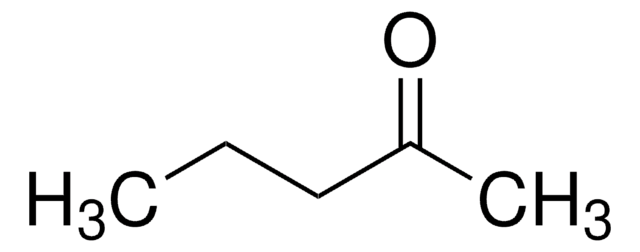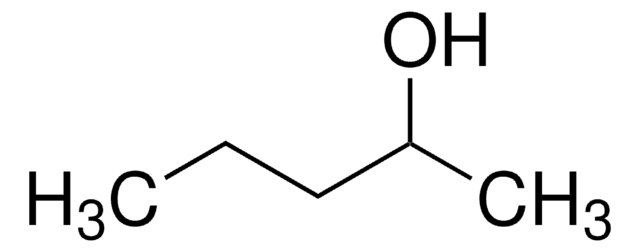All Photos(1)
About This Item
Linear Formula:
CH3CH2CH(OH)CH3
CAS Number:
Molecular Weight:
74.12
Beilstein:
773649
MDL number:
UNSPSC Code:
12352001
PubChem Substance ID:
Recommended Products
vapor density
2.6 (vs air)
vapor pressure
12.5 mmHg ( 20 °C)
Assay
≥99%
expl. lim.
9.8 %
refractive index
n20/D 1.397 (lit.)
bp
98 °C (lit.)
mp
−115 °C (lit.)
density
0.808 g/mL at 25 °C (lit.)
SMILES string
CCC(C)O
InChI
1S/C4H10O/c1-3-4(2)5/h4-5H,3H2,1-2H3
InChI key
BTANRVKWQNVYAZ-UHFFFAOYSA-N
Looking for similar products? Visit Product Comparison Guide
Choose from one of the most recent versions:
Already Own This Product?
Find documentation for the products that you have recently purchased in the Document Library.
Stefan Hofbauer et al.
Archives of biochemistry and biophysics, 574, 36-48 (2015-01-21)
Chlorite dismutase-like proteins are structurally closely related to functional chlorite dismutases which are heme b-dependent oxidoreductases capable of reducing chlorite to chloride with simultaneous production of dioxygen. Chlorite dismutase-like proteins are incapable of performing this reaction and their biological role
Flaminia Rondino et al.
Physical chemistry chemical physics : PCCP, 13(3), 818-824 (2010-12-07)
Diastereomeric adducts between (S)-1-(4-fluorophenyl)-ethanol and R and S 2-butanol, formed by supersonic expansion, have been investigated by means of a combination of mass selected resonant two-photon ionization-spectroscopy and infrared depletion spectroscopy. Chiral recognition is evidenced by the specific spectroscopic signatures
Feng Gao et al.
Journal of the American Chemical Society, 129(49), 15240-15249 (2007-11-16)
The enantioselective chemisorption of R- and S-propylene oxide has been measured either on clean Pd(111) that has been exposed to S-2-butanol at various temperatures to vary the proportion of 2-butanol and 2-butoxide species or by adsorbing S-2-butanol on oxygen-covered Pd(111)
Timothy E Morey et al.
AIDS and behavior, 17(1), 298-306 (2012-09-25)
A breath-based adherence system to document ingestion of oral medications (e.g., HAART) was investigated. Specifically, the food additive 2-butanol, which can be easily packaged with a drug, is converted via alcohol dehydrogenase to the volatile metabolite 2-butanone that rapidly appears
R A Rosenberg et al.
Physical review letters, 101(17), 178301-178301 (2008-11-13)
We demonstrate for the first time that low-energy spin-polarized secondary electrons, produced by irradiation of a magnetic substrate, can induce chiral-selective chemistry. Our approach was to perform detailed measurements of the reaction rate for x-ray induced, secondary electron photolysis of
Chromatograms
suitable for GCsuitable for GCsuitable for GCOur team of scientists has experience in all areas of research including Life Science, Material Science, Chemical Synthesis, Chromatography, Analytical and many others.
Contact Technical Service






